|
Geometric Vases from Greece. [1]
(1899 article in Jahrbuch des archäologischen Instituts vol. XIV, pp. 25-44)
Twenty-seven
years have now elapsed since Conze drew the attention of the learned
world to the Greek geometric vases in his well-known treatise On the
History of the Beginnings of Greek Art. Two years later G. Hirschfeld
was able to add a number of other geometric vessels to the group
discovered by Conze. To-day we have exceedingly rich material in this
field, but, despite this, knowledge of the geometric vases of Greece is
very little, even among archaeologists. In general, when judging these
vases, one has the same point of view as the discoverer of the
geometric vase style in Greece. But we would be bad students if we
couldn't get a little further.
After
the discovery of Conze, vast vistas of major areas of prehistoric
Greece were opened to us. Through Schliemann's brilliant finds, we then
became acquainted with a prehistoric period that lay before Homer and
was named the "Mycenaean" period after the main place where it was
found. On the other hand, we are now able to trace the development of
older Attic pottery through various intermediate stages, from the
cessation of the purely geometric style to the developed black-figure
style. Between these fairly well-known areas lies the period of the
geometric style that we are least familiar with.
Various
circumstances have brought it about that, in spite of the rich
material, we know so little of the Greek-Geometric style of vases.
First, the fact must be emphasized that apart from isolated exceptions
(such as Philios, Έφημερ. άρχαιολ. 1889 p. 172 ff. and Brückner-Pernice, Ein Attische Friedhof, Ath.Mitt. 1893 p. 73 ff.), reports are missing on the findings of vases
in Greece proper. Secondly, those researchers who have studied this
subject have somewhat hastily raised problems which were not yet ready
for a decision, either by trying to trace the origin of the geometric
style or by attributing a specific nationality to the makers of the
vases concerned. And thirdly, most investigators in this field lack
intimate acquaintance with the rich material at our disposal today.
This evil must be remedied, and for this purpose I want to compile the
most important material from Greece, as far as I know, in the following.
The
greatest part of the Greek Geometric vases is in Athens, but even there
it was not easy to survey the material concerned as late as three years
ago. It was only after Kavvadias successfully carried out the
rearrangement of the vase-rooms in the Athenian National Museum that it
became possible to study the geometrical vases in Athens with success.
By the courteous liberality of the General Ephorus of Greek Antiquities
I have been permitted to draw or photograph the most important
pertinent material in the National Museum of Athens, and now I proceed
to the publication of the Geometric Vases of Greece, it is my pleasant duty to express my sincere thanks to Elerm Kavvadias for the kindness with which he encouraged my investigations on the spot.
What
I want to give here is first of all a collection of material that could
serve as a basis for future investigations. The material comes mainly
from the National Museum in Athens and the Syllogos Collection in
Herakleion on Crete. Only in exceptional cases will I include
representative vases from other museums. I will compile this material
as clearly as possible; it will be evident that the geometric styles of
vases in Greece are very varied, and that every country or island has
its peculiar genus.
Due to the lack of land references for most
of the material, it will be impossible to present any historical
development within the geometric style. The Lund notes, which we have,
teach us, however, that the geometric style on the Attic vases must
have lasted a comparatively short time.
In this presentation, it
is particularly important to me to give as many illustrations as
possible, because only then is it possible to form an idea of the
variety in the geometric decoration, and only then will future
investigations on this be possible area to provide a proper document.
In this effort, the words of Conze in his above-cited treatise have
been decisive for me: "I have also collected the material more
completely than has been done up to now, and being able to refer to the
large quantity does not seem entirely unimportant to me when using it."
The
vases are arranged according to regions and islands. The vase forms
were decisive for the classification of the Attic dipylon vessels. The
text generally has the purpose to accompany the illustrations and to
emphasize the characteristic of each vase. Two essays have already
appeared as prolegomena to this work: "Aphidna in North Attika", Ath.Mitt. 1896 p. 385 ff. and "The Afterlife of Mycenaean Ornaments", Ath.Mitt 1897. p. 233 ff.
The dimensions (height, diameter of the mouth, maximum circumference) are given in metres.
THERA.
Technically,
the geometrically decorated Thera amphorae are reddish clay, sometimes
yellowish, with a coating that is usually light yellow, and a smooth
surface. The varnish used for decoration is often black-brown,
sometimes more violet-brown, sometimes red-brown, and in some pieces
almost yellow-brown.
The shape of the Theraic amphorae is
generally very heavy and squat. The neck is wide and low, slightly set
off from the body, the tip of the muzzle has a fairly sharp profile.
The abdomen has a strong swelling in the upper part and draws in more
or less strongly towards the foot. The two horizontal handles, slightly
tilted outwards, are attached to the top of the shoulder. The form of
these vessels is reminiscent of that of the πίθοι (pithoi) and is most
closely comparable with the large πίθος (pithos) (No. 807) preserved in
the Athenian National Museum [2].
Around the vessel go
horizontal bands, which (sometimes singly, sometimes in groups of two
or three) divide the surface of the vessel into several parallel
stripes, of which those on the abdomen are undecorated. Otherwise the
decoration is mainly limited to the neck and shoulders, namely to the
front part of the vessel, and is therefore only intended for the front
view from above. The stripes on the neck and shoulders are filled with
various ornaments, such as meanders, zigzag lines, circles and
so-called false spirals. Both the upper horizontal surface of the mouth
rim and the rim of the fin are decorated all around in a radial
direction by varnish strokes, which are repeated in groups of three or
four at certain distances.
The main interest of the decoration
falls on the front shoulder surface located between the two handles.
This stripe, which is usually left wider than the others, is not
provided with an ornament running evenly along the fangs, but is
divided partly by vertical and partly by horizontal narrow bands. A
square field is often left out in the middle, which usually contains a
wheel-shaped ornament. Such a field is often cut off in the upper
corners by a window-like square. The wheel ornament in the central area
of the shoulder surface forms a decorative motif that is particularly
characteristic of the Theraean vases.
Some of the painted
ornaments, especially the meanders and zigzag lines, are made in such a
way that the band lines are drawn with thin brush strokes, while the
interior is filled with oblique hatching (p.29) [3]. The triangular
motifs are doubly hatched on the inside and are therefore filled in
with lattice work.
Plant ornamentation is not represented at all
on these vases. Of the animal world we find only birds represented, and
in the usual dipylon scheme. Usually a bird is placed alone in a small
square field. On the Copenhagen vase such a bird holds a geometrically
stylized serpent in its mouth, and the same motif, albeit in a more
faded and misunderstood conception, is found on the Athenian vessel
from Thera, Nat. Mus. 824b. The Copenhagen amphora has four birds lined
up in two places in the lowest horizontal stripe decorated.
These
remarks apply to the Theraic Geometric style in general. Individual
deviations are to be discussed below at the relevant points.
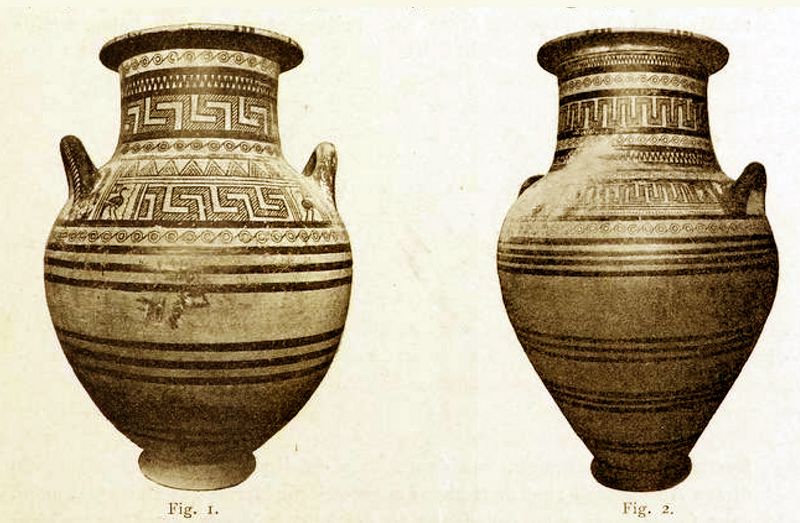
1)
Fig.1. Athens, Nat. Museum 824b. Height 0.51 m, diameter of the mouth
0.255 m, greatest circumference 1.165 m. In the small square fields on
the right and left of the shoulder surface a bird with a geometrically
stylized snake. However, the original motif does not seem to have been
properly understood.
2) Fig.2. Athens, Nat. Museum 892. H. 0.74. Dm. i.e. Mdg. 0.36. size 1.52.
3) Fig.3. Thera, owned by Lord Νομικός. I owe the photograph to Mr. Alfred Schiff. H. 0.40. Dm. i.e. Mdg. 0.25.
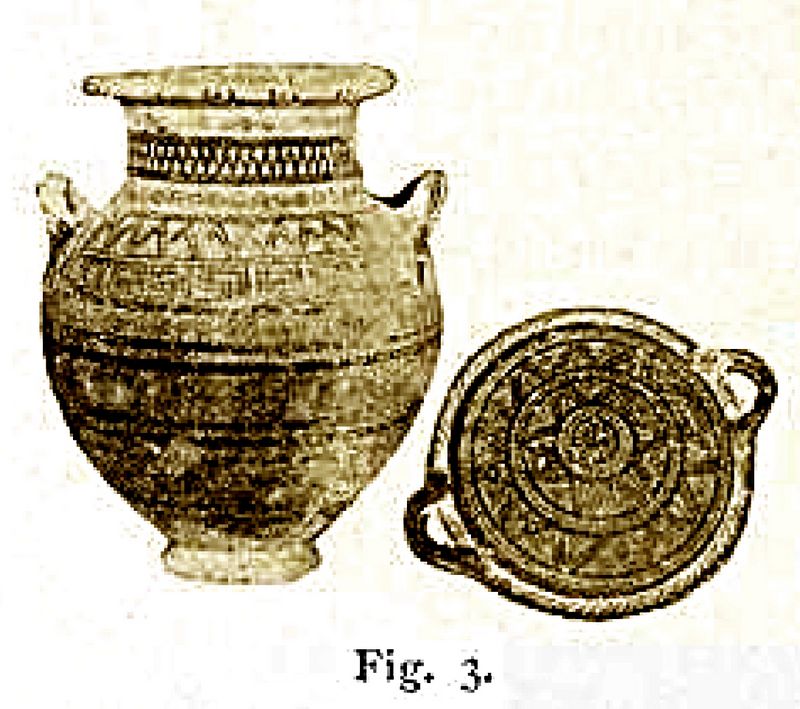
4) Fig. 4. Athens, Nat. Museum 893. H. 0.625. Dm. i.e. Mdg. 0.30. size 1.27.
5)
Fig. 5. Thera, owned by Lord Νομικός. I owe the photograph to Mr. Alfred
Schiff. The vase is fragmented. Maximum height 0.52. Dm. i.e. Mdg. 0.37.
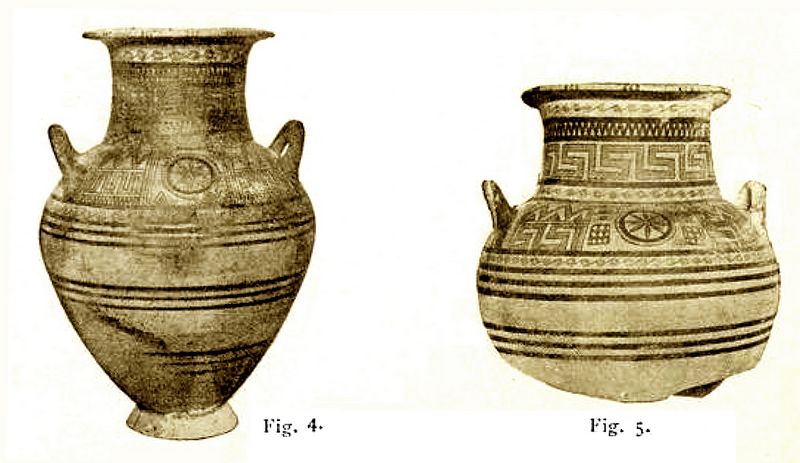
6)
Fig. 6. Athens, Nat. Museum 824 [4]. H. 0.75. Dm. i.e. Mdg. 0.36. size
1.57. In terms of decoration, this amphora offers something new
compared to the ones discussed above. The breakdown of the horizontal
stripes by vertical lines begins here at the neck. Among the ornaments
(p. 31) we meet here the "running dog," and in the middle of the lowest
decorated strip we find an ornament standing alone, from whose
description I refrain by referring to the accompanying illustration.
7)
Fig 7. Athens, Nat. Museum 824h H. 0.71. Dm. i.e. Mdg. 0.38. size
1,585. The division of the broad shoulder stripe has been taken a step
further here, in that three square main fields have been created.
Within these the principal ornament is not exactly wheel-like in form
as usual, but consists of five smaller wheel-shaped ornaments (or
concentric circles) within two larger concentric circles.
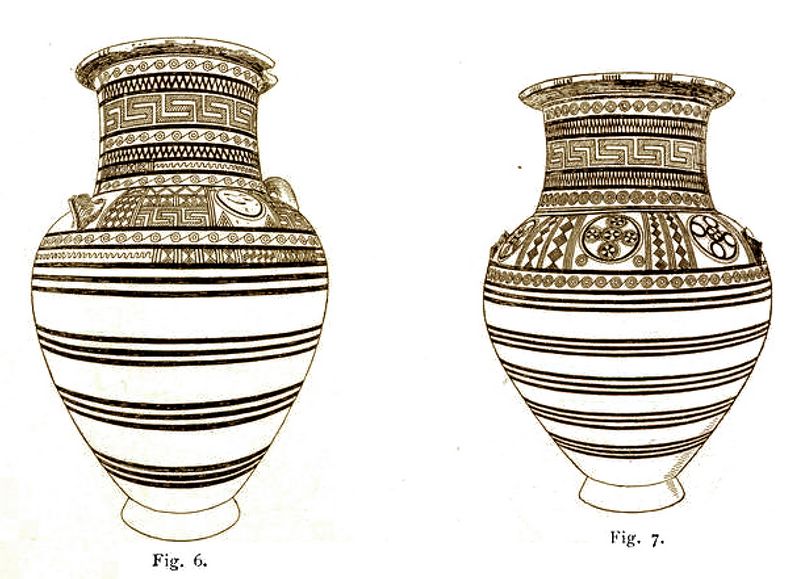
8) Fig. 8. Thera, owned by Lord Νομικός. Mr. Alfred Schiff kindly provided me with the photograph. H 0.77. Dm. i.e. Mdg. 0.36.
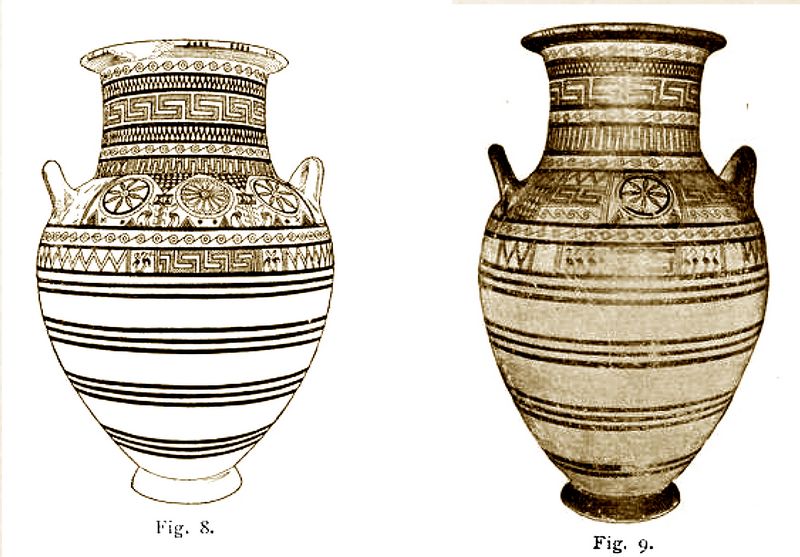
The zigzag
line with the hooks attached to the corners is a motif which, as far as
I know, occurs only once on the geometric vases, namely on a Leiden
vase, which has been reproduced by Conze, Zur Geschichte der Anfende der Hellen Kunst,
plate III 1. As a result, one may conclude that that vase, whose
provenance is not communicated, comes from Thera, like many other vases
reproduced by Conze op.cit.
9)
Fig. 9 [6]. Copenhagen, National Museum (Prindsens Palace). Large
reddish (p.33) clay with white-yellow coating. H 0.74. Dm. i.e. Mdg.
0.325. size 1.47
This amphora is slimmer in structure than the
Thera vases discussed previously. As for decoration, here for the first
time among Theraean vases we find a series of dipylon birds; at the
bottom of the shoulder surface appears an ornament showing a series of
real spirals in an evaporative representation.
10) Fig. 10. Athens, Nat.-Mus. 899. H. 0.275. Dm. i.e. Mdg. 0.105. size 0.53.

Closely
related to this vase is the Theraean amphora kept in the British Museum
under no. 409 (there erroneously attributed to Athens).
MELOS
We know Melische clay vessels with geometric patterns sufficiently from Conze, Melische Thonggefäfse (Leipzig 1862), Böhlau, Eine Melische Amphora, Arch. Jahrbuch 1887
p. 2ii ff. Plate 12 and Mylonas in the Έφημ. άρχαιολ. 1894. p. 225 ff.
Plates 12, 13, 14. These vases, however, have predominantly Mycenaean-
Oriental decorative elements, in addition to some traces of geometric
influence. Two vessels are shown here, representing the pure geometric
style of Melos.

The lower part of the vessel's body is
provided with horizontal wide bands filled with varnish, alternating
with groups of narrow horizontal lines. The actual decoration falls on
the surfaces between the handles.
The quadrangular main strip
is divided by vertical lines into three fields, a larger one in the
middle and a smaller one on each side. The central field is in turn
divided into three horizontal strips, two of which are decorated with
meander ornaments, while the third, in between, contains a row of small
rhombuses. The two side panels, which correspond exactly to each other
in terms of decoration, are each divided into an upper and a lower
panel: in the upper one there is a dipylon bird, in the lower one a
stag (on the opposite side of the vessel the stag has been replaced and
is represented by a horse in the corresponding place).
The
surfaces surrounding the handles are decorated with rad ornaments, and
a dipylon bird is painted under each bow of the double-arched neck. On
the outer side of the rim of the mouth runs a wavy line, which touches
small circles at its rises and falls. The same ornament is repeated in
a decorated horizontal stripe running just below the handles. In the Ath.Mitt.
1897 article (p.246) it has been shown that this ornament is a
geometrical simplification of the Mycenaean motif of the continuous
tendril.
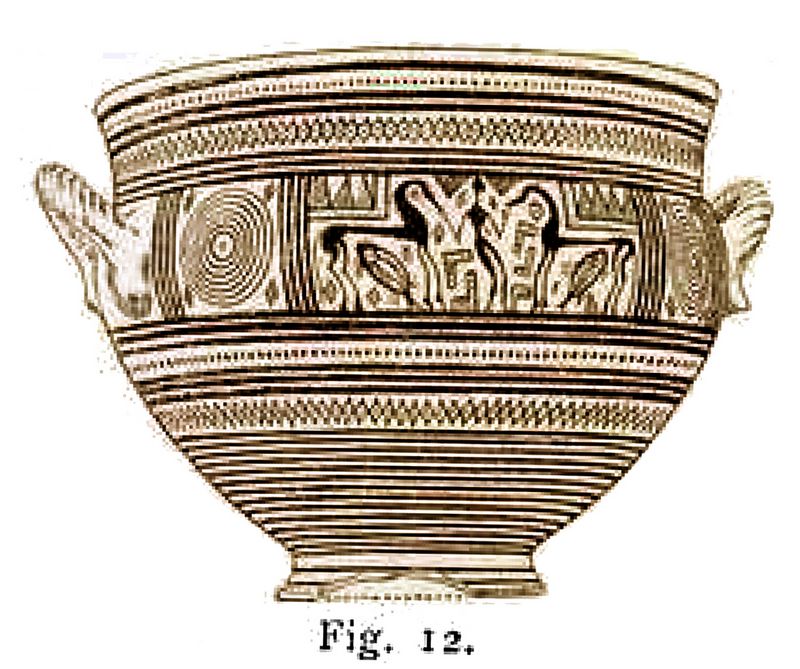
The
decorated main surface between the looped handles is divided into three
adjacent fields, a smaller one on each side and a larger one in the
middle. Each of the side panels is decorated with a system of
concentric circles. The middle field, the decorated main field, has a
window-like cut-out in each of the upper corners, which is filled with
hatched triangles. The main depiction is a man holding a horse by the
mouth in each hand. Under each horse a fish is used as a filling motif.
Other filling ornaments are hatched rhombuses, (p.35) triangles and
meander hooks. The same representation is repeated on the opposite side
of the vessel.
Below the main stripe are two narrower,
horizontal stripes, one filled with a row of dots, the other with a row
of small rhombuses. These decorative stripes are repeated at the top of
the neck.
Another vessel, which in all probability comes from
Melos, cannot be included here because the provenance is not given. It
will therefore be safer to treat it among the vases of unknown origin.
Footnotes:
1)
The essay was written in 1897. This also explains why some more recent
publications are not taken into account, which could not be dealt with
without revising the whole.
2) Pictured in the Ath.Mitt 1893 p. 134 and in Böhlau, Zur Ornamentik der Villanova-period
(commemorative publication of the XXVI Annual Meeting of the German
Anthropological Society) p. 9. The real spirals engraved on this πίθος have been replaced. on the Theraean amphorae by so-called false spirals (connected by tangents circles)
3)
Only on the Copenhagen amphora from Thera is there a meander, the whole
width of which is filled with full color of varnish. As Dragendorff
kindly informs me, such meanders came to light a few times during
Hiller's excavations on Thera.
4) Pictured Annali dell' Institute 1872, Ταυ. d'agg. K, 1, where, however, the shape of the vase is imprecisely reproduced.
5) On Hirschfeld's figure in Annali dell' Institute, op.cit. these concentric circles are improperly placed on the uppermost part of the shoulder.
6) Despite the fact that this vase has already been published in Conze, Melische Thongefässe p. VII and On the history of the beginnings of Greek art.
plate IX 2, I will have it reproduced here again because the
illustrations made there based on Michaelis' sketch are not sufficient.
7) The decorated main field with the pictorial representation is from Hirschfeld in the Annali dell' Institute 1872 Tav. d'agg. J. x (see text p. 140). There, however, an overall view of the vessel is missing.
[Continue to part 2]
[Return to table of contents]
|
|